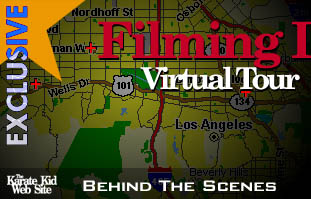
 |
Updated:
8th Mar 2003
|
| Exclusively Learn about the locations used in the making of The Karate Kid Part II. |
 |
|
"After
The Tournament"
- [New 4th Feb 2001]
At
the beginning of the movie, we are shown a montage of the first film, so that
viewers who didnt see the original can pick up the storyline. This is done deliberately,
becuase the sequel will pick up right where the original left off -- a style
that was continued for the next movie as well.
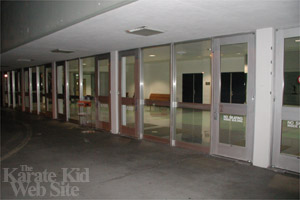 |
| The tournament exit as it is now (2001) [Chris Lozano] |
So
after Daniel bests Johnny with the "Crane" style at the tournament.
we cut to the showers and then to the exterior of the tournament.
Thanks to our Tournament Correspondent, Matt
H, we learned that these scenes were filmed at CSUN,
or California State University and more
recently thanks to our official LA Locations scout Chris
Lozano, we can now bring you the first published pics of the exterior
of the tournament location, Chris notes:
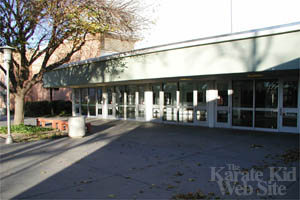 |
| The tournament courtyard as it is now (2001) [Chris Lozano] |
"When reviewing the scene in the movie I noticed subtle differences between
this location that I photographed and what is seen in Part II. This [pictured
left] is the only courtyard exiting the Tournament
location that looks like the one used for the parking lot in the film. My two
theories are, (A) this is the courtyard used in the movie and was altered by
some renovation in 1996 due to the 1994 Northridge earthquake. or (B) There
may have been an identical, destroyed, courtyard, used for the scene, on the
other side of what appears to have been a symetrical building. Major renovation
and large new structures now sit where a potentially identical courtyard may
have been on the opposite side of the building. Visitors will only find this
one area that appears similar to the parking lot scene in Part II."
Chris
also has a "conspiracy theory" that has some merit about the returning
Cobra Kai that, if true, would cast doubt on the previously held belief that
this scene was filmed at the same time as the original film and then left out
for the sequel (The scene was present in the script through all versions). He
explains:
"I noticed something odd in Karate Kid Part II
while reviewing the Kreese/Miyagi opening confrontation.
When Kreese is telling Johnny "you're nothing, you lost, you're a loser".. the
other Cobras are surrounding them on each side in front of the car and two behind
the car. They are all wearing Cobra Kai grey jackets. While Kreese chokes Johnny
and hits the two in front of the car .. the other two stay put behind the car.
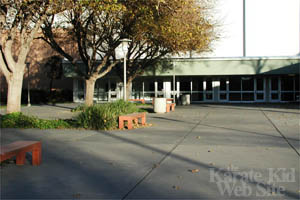 |
| Wider shot of the tournament courtyard exit as it is now (2001) [Chris Lozano] |
But
curious to me is who is the guy behind the car on the left in the "BASEBALL
CAP PULLED OVER HIS EYES WHO TURNS AWAY FROM THE CAMERA"?? Is that supposed
to be Dutch? It sure doesn't look like Chad McQueen hiding under the cap to
me. As I recall, at the beginning of the Part II end credits the "returning
cobras" are all listed including McQueen. I don't believe Chad McQueen is in
the opening Kreese/Miyagi confrontation in Part II.
Would you please confirm or deny if all the original Cobras really did return
for the fight in the parking lot. If not.. maybe the fight really wasn't filmed
during the first film but over a year later for Part II(just guessing)... it
seems strange to me that McQueen wouldn't be clearly visible (or available)
for what might have been the possible climactic Kreese/Miyagi confrontation
filmed for the end of the original Karate Kid. Especially when the scene so
conveniently opens by cleverly explaining Ali and Daniel's mom are "waiting
at the restaurant".
I really wonder if the scene was filmed much later when maybe "Elisabeth Shue,
Chad McQueen, and Randee Heller" were nowhere around the set to film the scene
for Part II. Its possible.. but I still think it's odd 3 very visible characters
seen inside the tournament... suddenly dissapear for what might have been the
original Karate Kid movie climax outside the tournament. But hey... Dutch is
hiding under his cap and Mom and Ali are long gone... why?"
I have studied the bit in the movie, but can't be sure. What does
everyone think?
"Man, I Thought Chung Lee's Chinese Restaurant Was Good"
- [last updated 27th Sept 1999]
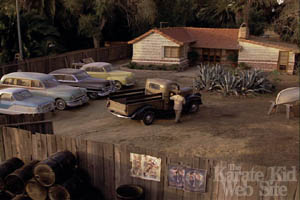 After the beginning of the movie which was shot at the same time as the tournament
scenes in the original Karate Kid movie [at California State University, Northridge],
we return to Miyagi's house "6 Months Later" This is still the
only major unknown location of the film.
After the beginning of the movie which was shot at the same time as the tournament
scenes in the original Karate Kid movie [at California State University, Northridge],
we return to Miyagi's house "6 Months Later" This is still the
only major unknown location of the film.
-NEW!
We
now know that this location was just "a rundown shack in a weedy yard until
the construction crew descended upon it. When they were finished, the interior
became a modest and beautifully austere Japanese dwelling with mats, screens
and other authentic Oriental accoutriments. The yard itself was landscaped with
miniature mountains, lanterns, decking, a pond complete with expensive koi (Japanese
fish) and hundred-year old bonsai." -Source
KK II Press Kit
This location appears to be near railway tracks and an oil industry storage
area or junkyard..
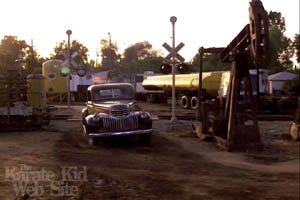 It was designed
and prepared under the watchful eye of art director William Cassidy, who cited
Mr. Miyagi's house as being the big challenge of the picture, where the design
of his home had to "reveal his true serenity of spirit. His philosophy
as a pacifist and a stoic had to be made organic in the movie"
It was designed
and prepared under the watchful eye of art director William Cassidy, who cited
Mr. Miyagi's house as being the big challenge of the picture, where the design
of his home had to "reveal his true serenity of spirit. His philosophy
as a pacifist and a stoic had to be made organic in the movie"
C'mon
folks, we *must* be able to find this location if we all work together. If anyone
has *any* information, guesses, suspicions or whatever, please write
to us.
In
KK III, in some of the scenes you can see a 5 or 10 story office building or
other commercial facility in the background... can you see Miyagis run down
yard from your office?
Please contact
us
Into Okinawa
-[NEW 11th July 2000]
Miyagi's house in "The Karate Kid" was carefully designed to express all the
serenity and inner beauty of its owner.
Finding the right Okinawan village one that would not only define Miyagi's roots
but also represent what production designer William J. Cassidy terms "the last
shred of sanity and modest aesthetics in a world of concrete," was considerably
more of a challenge.
Extensive location scouting had quickly revealed that modern-day Okinawa would
never do --military bases there have altered too drastically the local countryside.
Japan too was scouted and was under strong consideration when the ideal location
was found by the filmmakers on the Hawaiian island of Oahu at a spot 20 miles
from Honolulu on the north coast, in a scenic area called Kahaluu.
On private property and thus inaccessible by car, the "Okinawa" location was
first spotted in an aerial survey from a helicopter and was later approached
by the film- makers in a boat. Covered with palms, the idyllic spot encompasses
43 acres of shore front, complete with a lagoon which had once served as a royal
fish pond for King Kamehameha III. In the Great Mahele, or land division. of
1848, one which gave one-third of the land on the island to the common people
and one-third to the Ali'i, or royal chieftains, this shoreline property passed
to the ownership of one of the latter, Mahea, and had been in the hands of his
descendants for generations.
The beautiful location is currently owned by a retired local physician, who
has substantially reconstructed the pond while retaining its ingenious design.
Water flowed over the top at high tide, bringing in fish. Then they were prevented
from returning to sea on the outgoing tide by three makahas, or sluice gates,
which had wooden slats set one-half inch apart, keeping the mullet, eels, barracuda,
tarpon and other species for the royal gill nets.
The doctor and his daughter had refused numerous offers for commercial development,
and had, in fact, formed a corporation to guarantee the site's preservation.
Closed to the public, there seemed little likelihood of the land's owners allowing
a film company to come in with bulldozers to build a village" and bring in actors
and crew to photograph a movie on the property.
Miraculously, two things made it all possible Morita, a frequent visitor and
popular favorite in Hawaii, had previously made several appearances at fund-raisers
for State Senator Duke Kawasaki, a close friend of the doctor's. Furthermore,
the doctor's daughter worked for the Mayor of Honolulu one of whose pet projects
was encouraging filmmakers to location in the Islands.
So permission was soon given for the village to be constructed, supervised by
Hank Wynands, who years ago built the sets for "Hawaii".
The palms along a narrow strip of shoreline were soon bulldozed, and in their
place, over the course of two months' construction, rose seven houses exactly
identical to those in today's Okinawan villages. Cassidy, along with art director
Bill Matthews, had designed them to be built of stucco and wood, topped with
thatch, tile or tin, then topped again with rickety TV antennae and surrounded
with imitation coral rock.
A Shinto shrine was built in the form of a remodeled granary, in keeping with
historical custom; pens for chickens and goats were put up; an "abandoned" cannery
was erected on the sea wall, and an Army barracks and helicopter landing pad
were constructed on land adjacent to the site.
While 12 construction workers were doing the building, seven greensmen, under
the supervision of Walter Malterre, laboriously hand-tilled the rocky soil,
turning it into fields There they planted artificial rice and turnips, which
looked artificial, and so Avildsen, a stickler for authenticity, objected. The
fields had to be real. It is not just a tribute to Hawaii's fertile soil that
when filming started there were over three acres under cultivation with tomatoes,
green onions, zueehini, Japanese eggplant, peppers, cucumbers, pomegranates
and other crops indigenous to Okinawa all growing mightily. For several weeks
prior Malterre had been buying crops literally out of the fields of nearby farmers,
transplanting them at night, when the weather was cooler.
Principal photography began September 23, 1985, after a week of rehearsals,
and in keeping with the milieu of the film and in deference to the 50 Okinawa-born
Hawaii residents recruited to portray the villagers, a colorful Shinto ceremony
filming was preceded by Bishop Shigemaru Miyao who had headed the Izumu Taisha
Kyo Mission for the past 54 years and his assistant minister, Hiroomi Ito, blessed
the health and well-being of the cast and crew in an ancient ritual before an
altar covered with offerings of sake, vegetables, fruits and mochi, ceremonial
candles and green sakaki branches with white paper streamers. After a traditional
sip of sake, the blessing of the Kami was evoked for the success of the filming
enterprise.
NEW: David Yee wrote in to say:
"About 10 years ago, I had the opportunity to see
the location. By that time, all the shacks had been removed except one. Since
then, the property has been further developed with construction of a chapel.
I think the helicopter pad that was built for the film was also saved at the
time I visited the property. I heard that then Vice-President Bush landed there
not too long after the film was made"
Later, in October, shooting resumed at The Burbank Studios in California, first
on a specially designed street set replicating Naha, Okinawa's main city, and
then on a giant set constructed on a sound stage --where moat-surrounded ruins
of an ancient castle became the site of the colorful "O Bon dance" and
a fierce battle between Daniel and Chozen that provides the film's climactic
finale.
|
||
|
Don't forget to visit our parent site @ www.fast-rewind.com. We have the most comprehensive information on 80s movies of any site on the web and we're a non-commercial site too --free of pop-ups and other distractions. Along with the best movie locations information, we have reviews, trivia, pictures and so much more for many of your favorite 80's movies. Click here to go to our 80's homepage and thank you for visiting us. |
Well, that's our look at the real life locations used for the movie Karate Kid Part II. If anyone's visiting Oahu sometime, go have a look, and see if you can get any pictures!
Also, please remember to give me feedback. Was the article interesting? Have you got anything to add? Are there any errors that you can correct me on?
This
site is Copyright ©2000 Nick Alaway/Fast Rewind Websites. No part of it is to
be used on another site or in any printed publication or for any use whatsoever
without the express, written consent of the author.
Certain images that are used are Copyright 1985 Columbia Pictures Inc.
|
Movie & All Images ©1984
Columbia Pictures.
Please see the legal section
for details.
Link eXchange Banner |
|
©1999 Fast Rewind WebSites. All Right Reserved. |